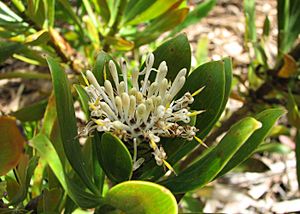Fletcher's drumsticks facts for kids
Quick facts for kids Fletcher's drumsticks |
|
|---|---|
 |
|
| Isopogon fletcheri in Maranoa Gardens | |
| Conservation status | |
| Scientific classification | |
| Genus: |
Isopogon
|
| Species: |
fletcheri
|
 |
|
| Occurrence data from Australasian Virtual Herbarium | |
Isopogon fletcheri, often called Fletcher's drumsticks, is a special plant. It belongs to the Proteaceae family. This plant is found only in a small area of the Blue Mountains in New South Wales, Australia.
It grows as a bushy shrub. Its leaves are narrow and shaped like an egg or a spear. The flowers are yellowish or creamy green and grow in round or egg-shaped clusters.
Contents
What Fletcher's Drumsticks Looks Like
Fletcher's drumsticks is a shrub that stands upright and looks bushy. It usually grows to be about 1 to 1.5 meters tall. Its branches are reddish-brown and smooth, meaning they have no hairs.
Leaves and Flowers
The leaves are long and narrow. They can be 40 to 120 millimeters long and 5 to 20 millimeters wide. They are attached directly to the stem without a stalk.
The flowers grow in clusters that are shaped like a top or an egg. These clusters are about 20 to 25 millimeters wide. At the bottom of each cluster, there are overlapping, egg-shaped leaves called bracts.
Each flower is about 15 millimeters long. They are yellowish to creamy green and also smooth. You can see these flowers from September to November.
Fruit and Seeds
After flowering, the plant produces fruit. The fruit is a hairy, oval-shaped nut that is 2 to 3 millimeters long. These nuts grow together, forming a round cone up to 20 millimeters wide.
How It Got Its Name
The plant Isopogon fletcheri was first officially described in 1894. A scientist named Ferdinand von Mueller gave it its name. He wrote about it in a scientific paper.
He named it after Joseph James Fletcher. Fletcher was the person who collected the first samples of this plant. He found them near Blackheath, looking over the Grose Valley.
Where Fletcher's Drumsticks Lives
Fletcher's drumsticks grows in forests. It likes to live very close to waterfalls, especially where the water spray reaches. It is usually found near sandstone cliffs in a few spots around Blackheath.
Why It Needs Protection
This plant is considered "vulnerable." This means it is at risk of disappearing. Both the Australian Government and the New South Wales Government protect it under special laws.
Threats to the Plant
There are several reasons why Fletcher's drumsticks is vulnerable:
- Small Population: There are not many of these plants left.
- Limited Area: It only grows in a very small part of the world.
- Disease: A plant disease caused by Phytophthora cinnamomi can harm it.
- Human Activity: People walking and rock climbing can disturb the plants.
- Weeds: Other plants, called weeds, can invade its habitat and take over.
Growing Fletcher's Drumsticks
You can grow this plant in gardens. It is quite tough if it has soil that drains water well. When you fertilize it, you should use products that are low in phosphorus.


